Page 96 of 340
Downloaded from www.Manualslib.com manuals search engine Your outside mirrors must be folded in before entering a carwash. To fold,
pull the mirrors
in towards the vehicle. fish the mirrors back out when
finished.
Convex Outside Mirror
Your right side mirror is convex.
A convex mirror’s surface is curved so you can see more from the driver’s
seat.
Sun VisorsNanity Mirrors
To block out glare, you can swing down the visors. You can also swing them
from side to side. Your visors have an extension that can be pulle\
d
out for
additional glare protection.
2-50
Your visor will have a
strap for holding small
items, such as maps.
Page 105 of 340
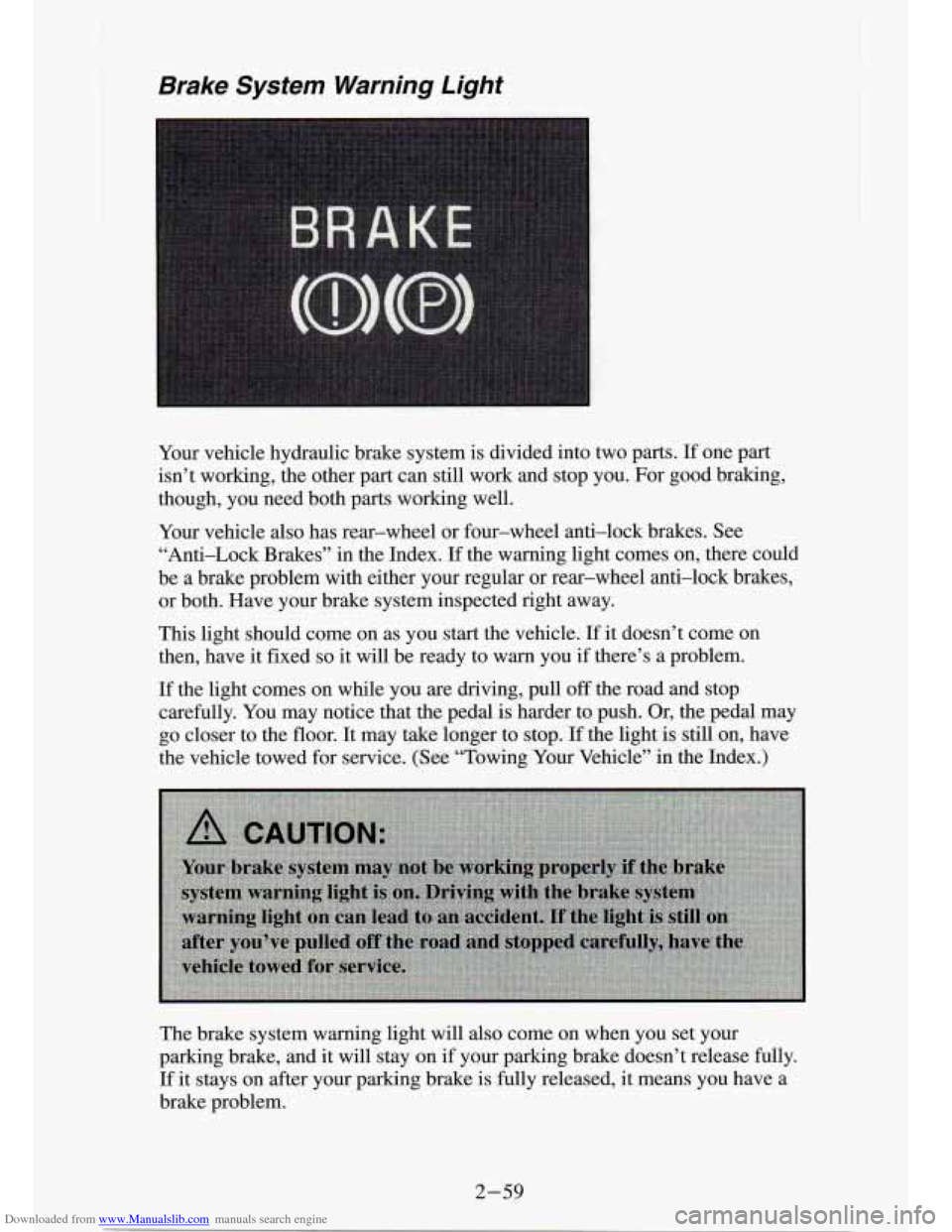
Downloaded from www.Manualslib.com manuals search engine Brake System Warning Light
Your vehicle hydraulic brake system is divided into two parts. If one part
isn’t working, the other part can still work and stop you. For good braking,
though, you need both parts working well.
Your vehicle also has rear-wheel or four-wheel anti-lock brakes. See \
“Anti-Lock Brakes” in the Index.
If the warning light comes on, there could
be a brake problem with either your regular or rear-wheel anti\
-lock brakes, or both. Have your brake system inspected right away.
This light should come on as you start the vehicle.
If it doesn’t come on
then, have it fixed
so it will be ready to warn you if there’s a problem.
If the light comes on while you are driving, pull off the road and stop
carefully. You may notice that the pedal
is harder to push. Or, the pedal may
go closer to the floor. It may take longer to stop.
If the light is still on, have
the vehicle towed for service. (See “Towing Your Vehicle” in the Index.)
The brake system warning light
will also come on when you set your
parking brake, and it will stay on
if your parking brake doesn’t release fully.
If it stays on after your parking brake is fully released, it means you have a
brake problem.
2-59
Page 117 of 340
Downloaded from www.Manualslib.com manuals search engine Air Vents
You will find air vents in the center and on the sides of your instrument
panel. You can move the vents to direct the flow
of air, or close the vents
altogether. When you close a vent,
it will increase the flow of air coming out
of any vents that are open.
Heater Controls
If your vehicle does
not have
air
conditioning, your
heater controls will
look like this.
The switch on the righthand side changes the fan speed. To increase the
fan
speed, push the switch upward toward HI. To decrease the fan speed, push
the switch downward toward
LO .
The upper knob changes the air temperature. Turn the knob right (clockwise)
for warmer
air. Turn the knob left (counterclockwise) for cooler air.
The lower knob changes the heater function and determines which\
outlets
the
air will flow through (instrument panel, defroster, heater, etc.).
3-3
Page 118 of 340
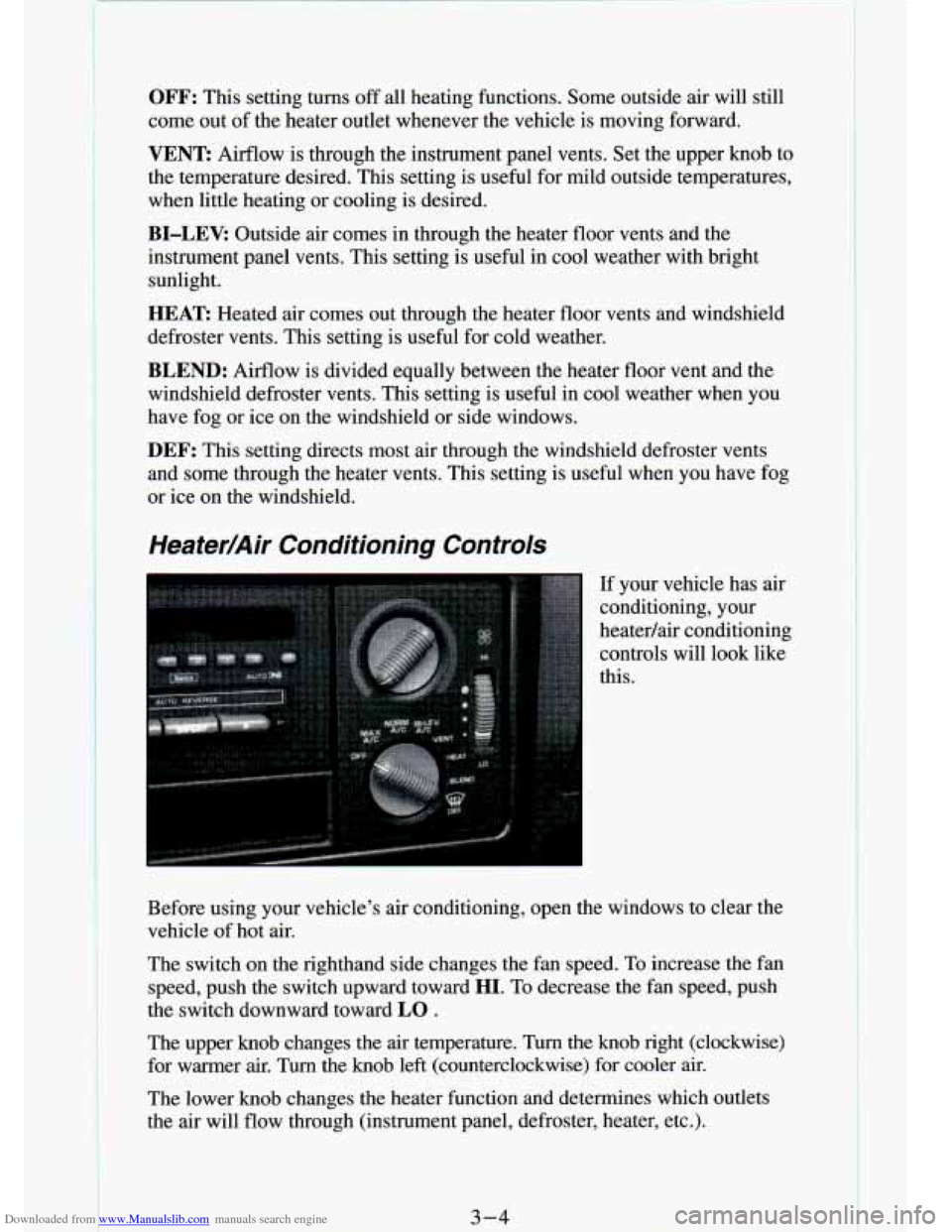
Downloaded from www.Manualslib.com manuals search engine OFF: This setting turns off all heating functions. Some outside air will still
come out of the heater outlet whenever the vehicle is moving forward.
VENT Airflow is through the instrument panel vents. Set the upper knob to
the temperature desired. This setting is useful for mild outside temperatures,
when little heating
or cooling is desired.
BI-LEV: Outside air comes in through the heater floor vents and the
instrument panel vents. This setting is useful in cool weather \
with bright sunlight.
HEAT Heated air comes out through the heater floor vents and windsh\
ield
defroster vents. This setting is useful for cold weather.
BLEND: Airflow is divided equally between the heater floor vent and t\
he
windshield defroster vents. This setting is useful in cool weather when you
have fog or ice on the windshield or side windows.
DEF: This setting directs most air through the windshield defroster \
vents
and some through the heater vents. This setting is useful when\
you have fog
or ice on the windshield.
Heater/Air Conditioning Controls
If your vehicle has air
conditioning, your
heatedair conditioning
controls will look like
this.
Before using your vehicle's air conditioning, open the windows \
to clear the vehicle
of hot air.
The switch on the righthand side changes the fan speed. To increase the fan
speed, push the switch upward toward
HI. To decrease the fan speed, push
the switch downward toward
LO .
The upper knob changes the air temperature. Turn the knob righ\
t (clockwise)
for warmer air. Turn the knob left (counterclockwise) for coo\
ler air.
The lower knob changes the heater function and determines which out\
lets
the air will flow through (instrument panel, defroster, heater, etc\
.).
3-4
Page 137 of 340
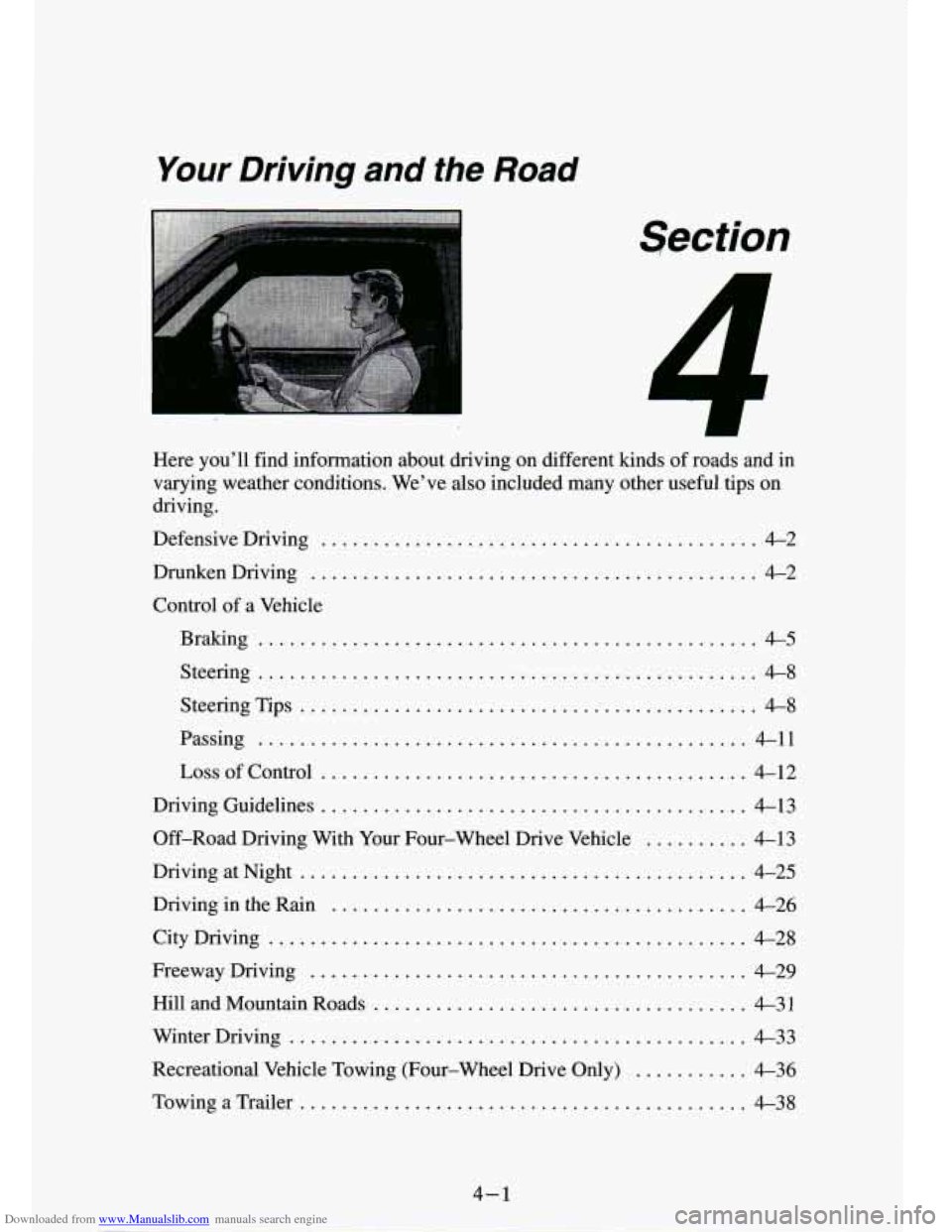
Downloaded from www.Manualslib.com manuals search engine Your Driving and the Road
Section
.
Here you’ll find information about driving on different kinds\
of roads and in
varying weather conditions
. We’ve also included many other useful tips on
driving
.
Defensive Driving .......................................... 4-2
Drunken Driving
........................... : ............... 4-2
Control of a Vehicle
Braking
................................................ 4-5
Steering ................................................ 4-8
Steering Tips
............................................ 4-8
Passing
............................................... 4-11
Loss of Control ......................................... 4-12
Driving Guidelines
......................................... 4-13
Off-Road Driving With Your Four-wheel Drive Vehicle
.......... 4-13
DrivingatNight
........................................... 4-25
Driving in the Rain
........................................ 4-26
Freeway Driving
.......................................... 4-29
CityDriving
.............................................. 4-28
Hill and Mountain Roads
.................................... 4-31
WinterDriving
............................................ 4-33
Recreational Vehicle Towing (Four-wheel Drive Only)
........... 4-36
TowingaTrailer
........................................... 4-38
4-1
Page 172 of 340
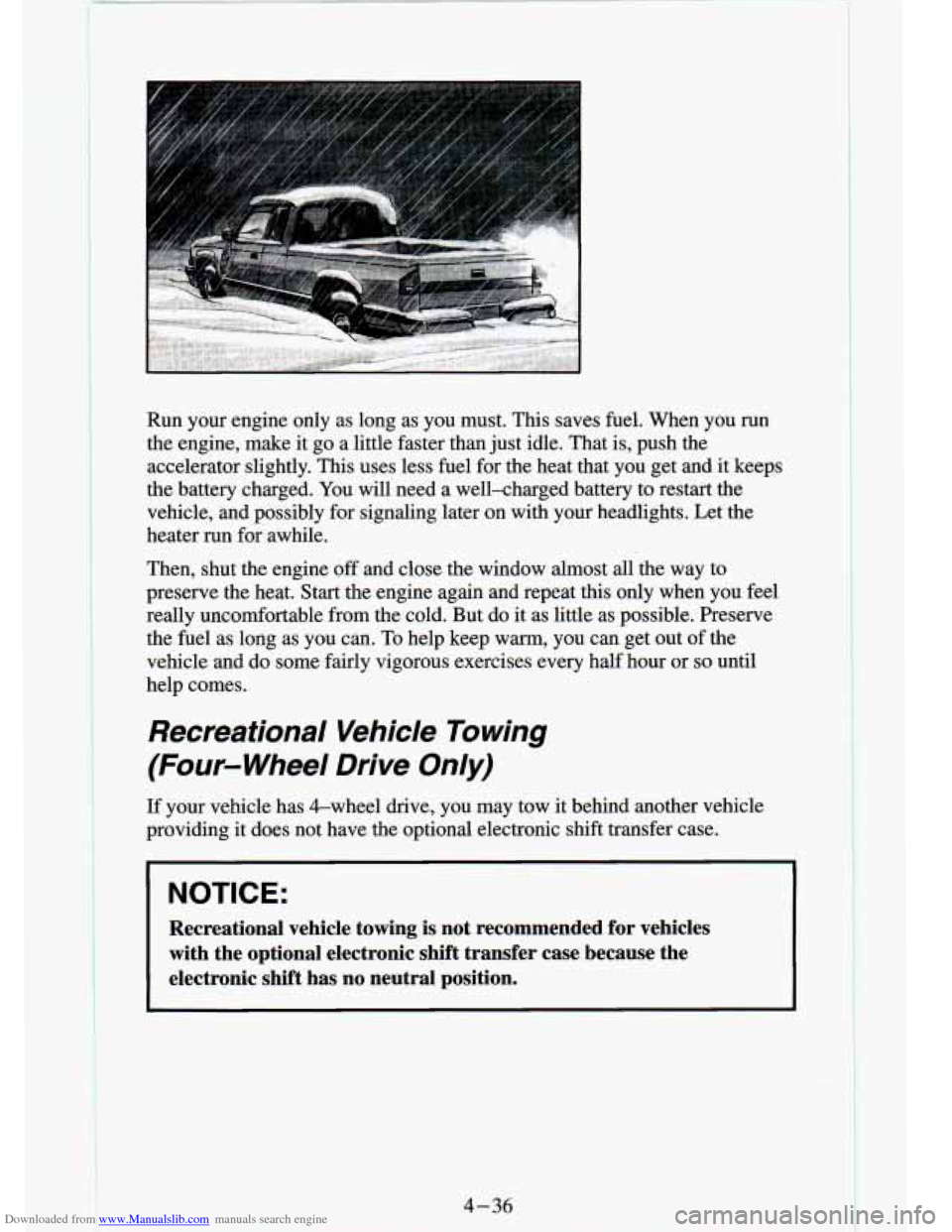
Downloaded from www.Manualslib.com manuals search engine Run your engine only as long as you must. This saves fuel. When you run
the engine, make it go a little faster than just idle. That is, push the
accelerator slightly. This uses less fuel for the heat that you get and it keeps
the battery charged. You will need a well-charged battery to restart the
vehicle, and possibly for signaling later on with your headlights. Let the
heater run for awhile.
Then, shut the engine off and close the window almost all the way to
preserve the heat. Start the engine again and repeat this only\
when you feel
really uncomfortable from the cold. But do it as little as possible. Preserve
the fuel as long as you can. To help keep warm, you can get out of the
vehicle and do some fairly vigorous exercises every half hour \
or
so until
help comes.
Recreational Vehicle Towing
(Four- Wheel Drive Only)
If your vehicle has &wheel drive, you may tow it behind another vehicle
providing it does not have the optional electronic shift transfer case.
NOTICE:
Recreational vehicle towing is not recommended for vehicles
with the optional electronic shift transfer case because the
electronic shift has no neutral position.
4-36
Page 173 of 340
Downloaded from www.Manualslib.com manuals search engine Before towing, you should:
1. Set the parking brake firmly.
2. Place the automatic transmission in “P’ (Park) or the manual
transmission
in the lowest gear (1 st gear).
hitch manufacturer’s instructions.
3. Firmly attach
the vehicle being towed to the tow vehicle. Refer to the
4. Place the transfer case shift lever in “N’ (Neutral).
5. Release the parking brake only after the vehicle being towed i\
s firmly
6. Insert the ignition key into the ignition switch and turn it one notch
forward
of the LOCK position. This places the key into the OFF
po.sition, which unlocks the steering column while preventing battery
drain. Unlocking the steering column
will allow for proper movement
of the front wheelshires during towing.
attached to
the tow vehicle.
I NOTICE:
I You should exercise extra care whenever towing another vehicle.
4-37
Page 174 of 340
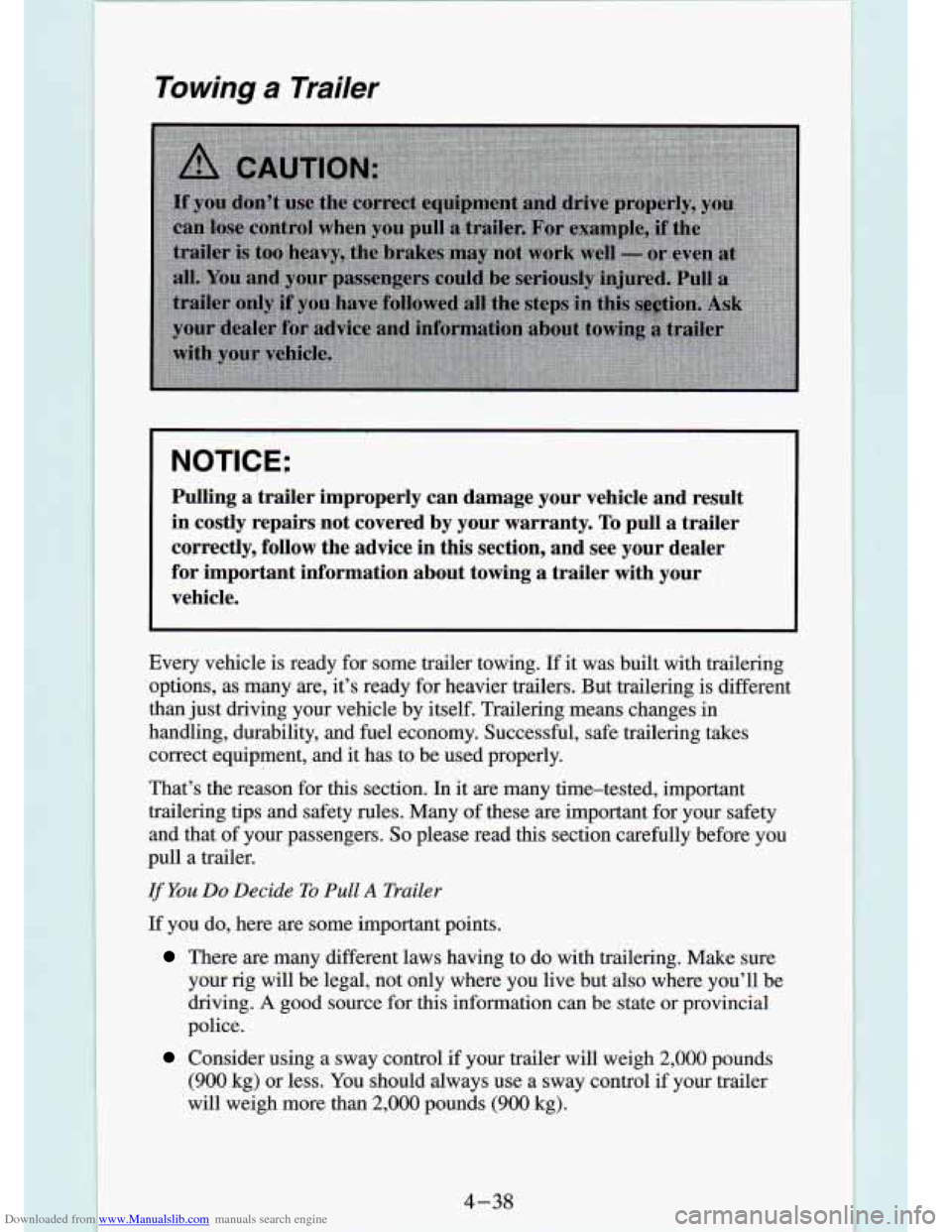
Downloaded from www.Manualslib.com manuals search engine Towing a Trailer
NOTI.CE:
Pulling a trailer improperly can damage your vehicle and result\
in
costly repairs not coveredby your warranty. To pull a trailer
correctIy, follow the advice
in this section, and see your dealer
for important information about towing a trailer with your
vehicle.
Every vehicle is ready for some trailer towing. If it was built with trailering
options, as many are, it’s ready for heavier trailers. But trailering is different
than just driving your vehicle by itself. Trailering means changes in
handling, durability, and fuel economy. Successful, safe trailering takes
correct equipment, and it has to be used properly.
That’s the reason for
this section. In it are many time-tested, important
trailering tips and safety rules. Many
of these are important for your safety
and that of your passengers.
So please read this section carefully before you
pull a trailer.
If You Do Decide To Pull A Trailer
If you do, here qre some important points.
There are many different laws having to do with trailering. Ma\
ke sure
your rig will be legal, not only where you live but also whe\
re you’ll be driving.
A good source for this information can be state or provincial
police.
Consider using a sway control if your trailer will weigh 2,000 pounds
(900 kg) or less. You should always use a sway control if your trailer
will weigh more than
2,000 pounds (900 kg).